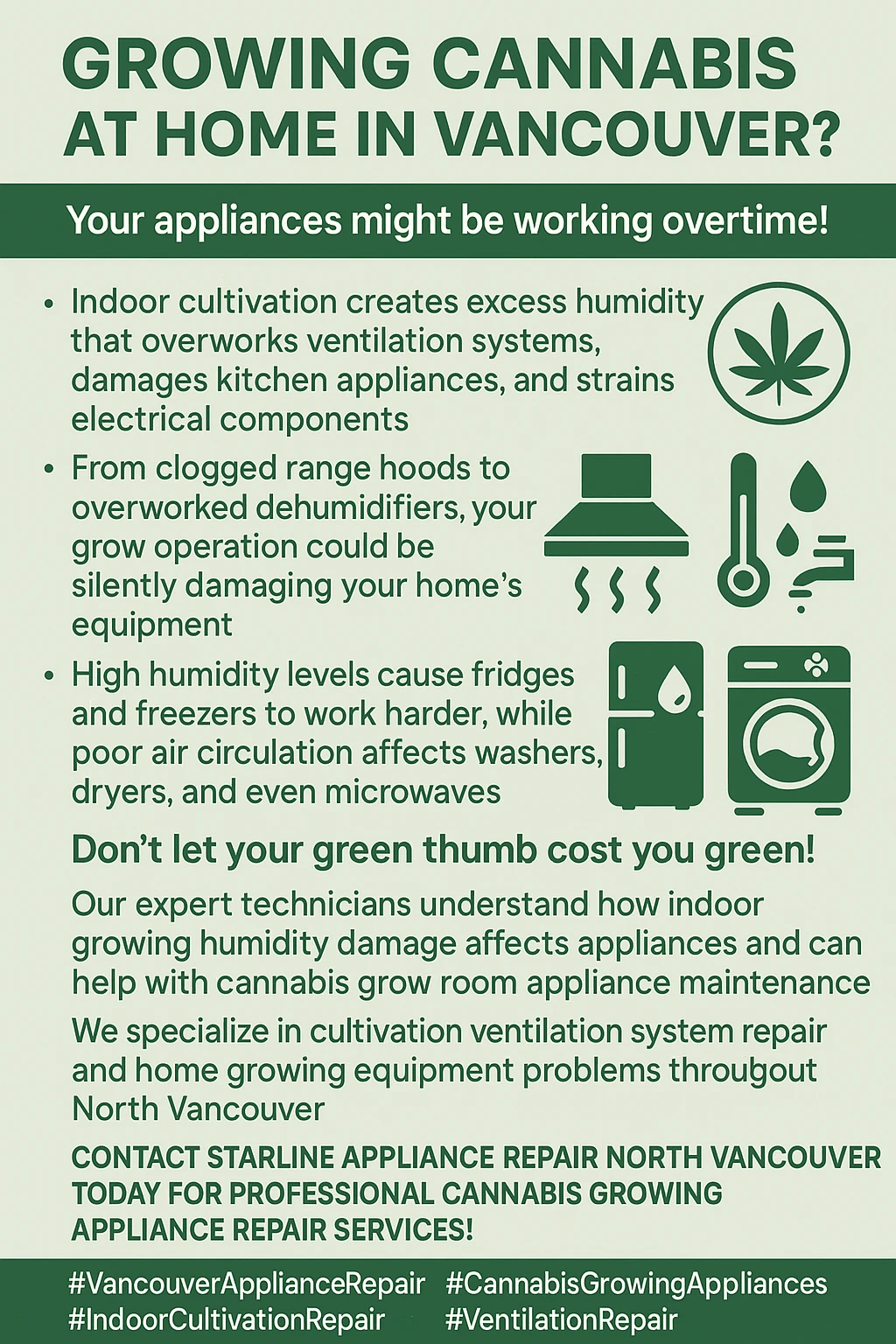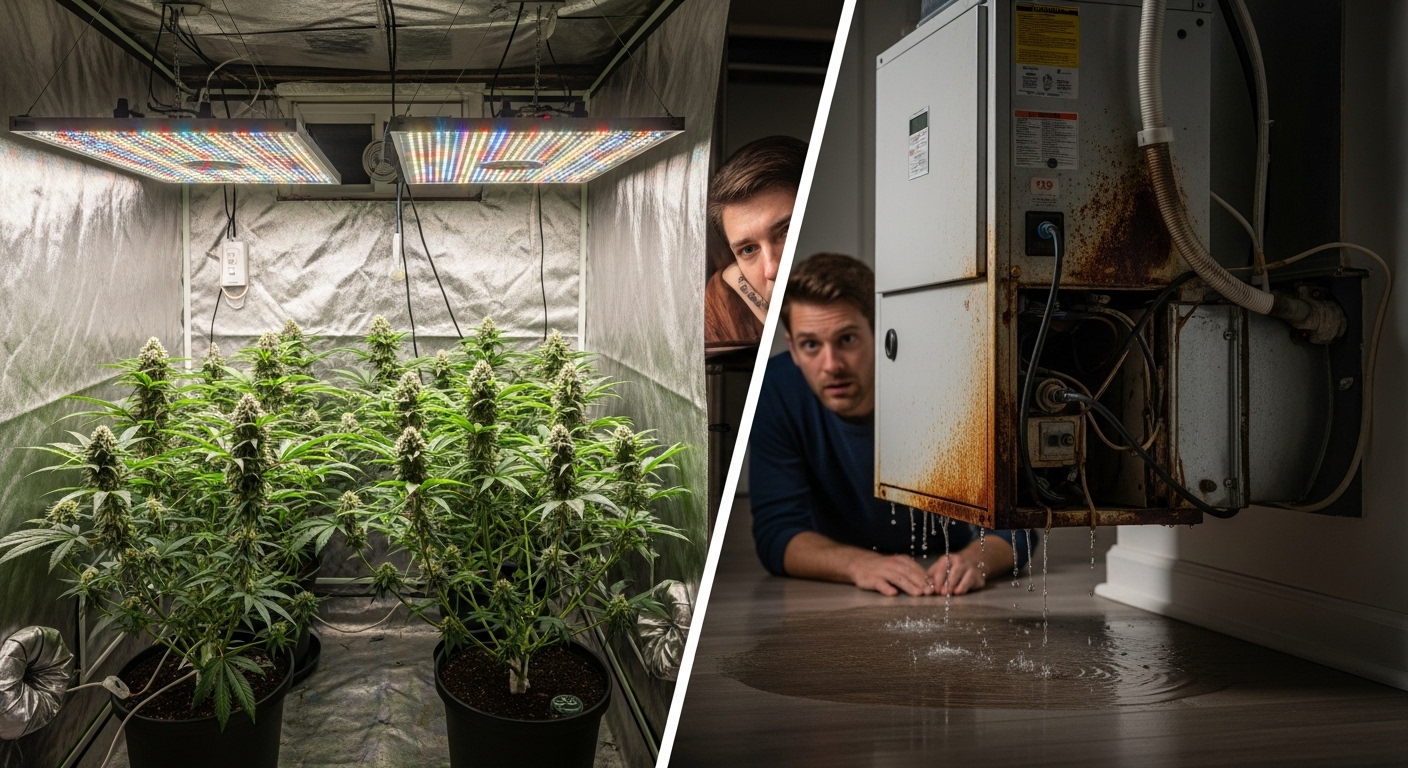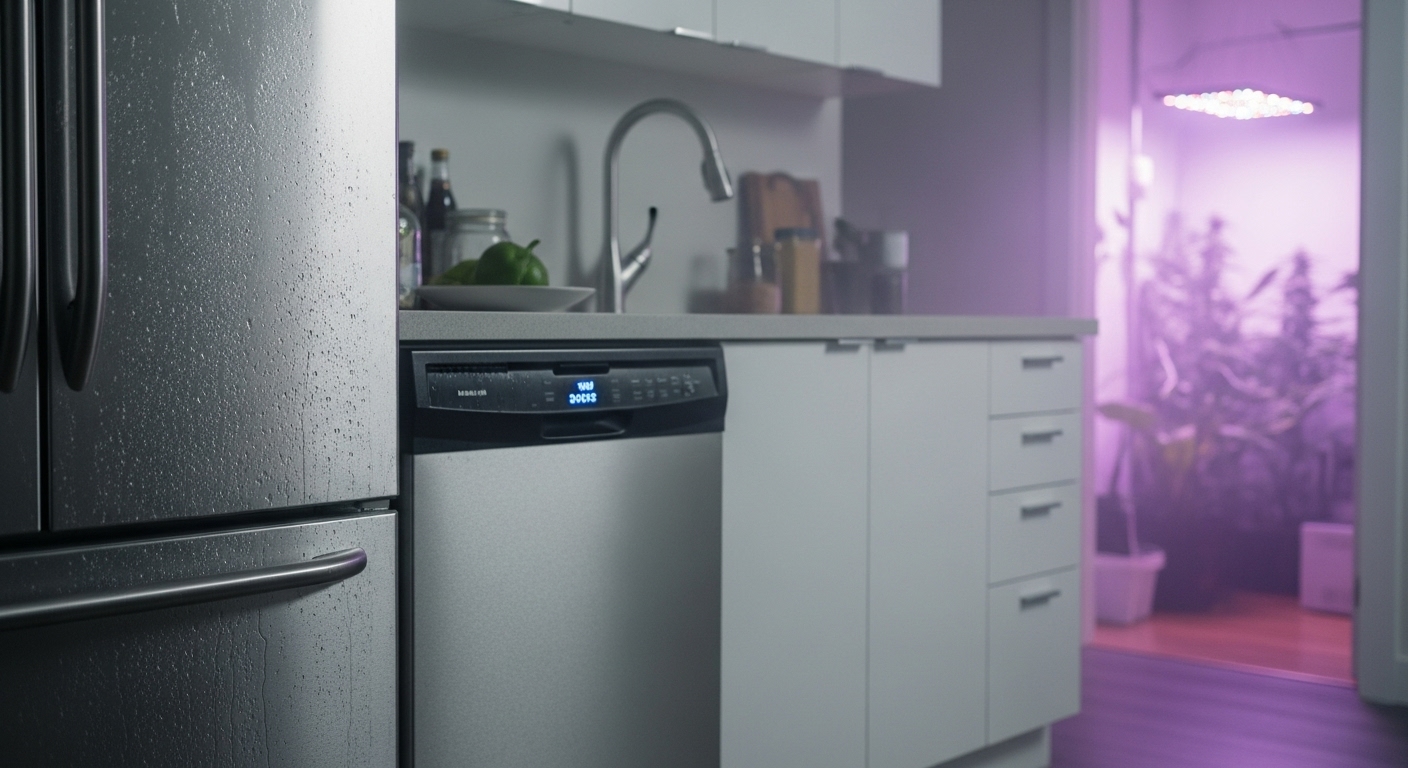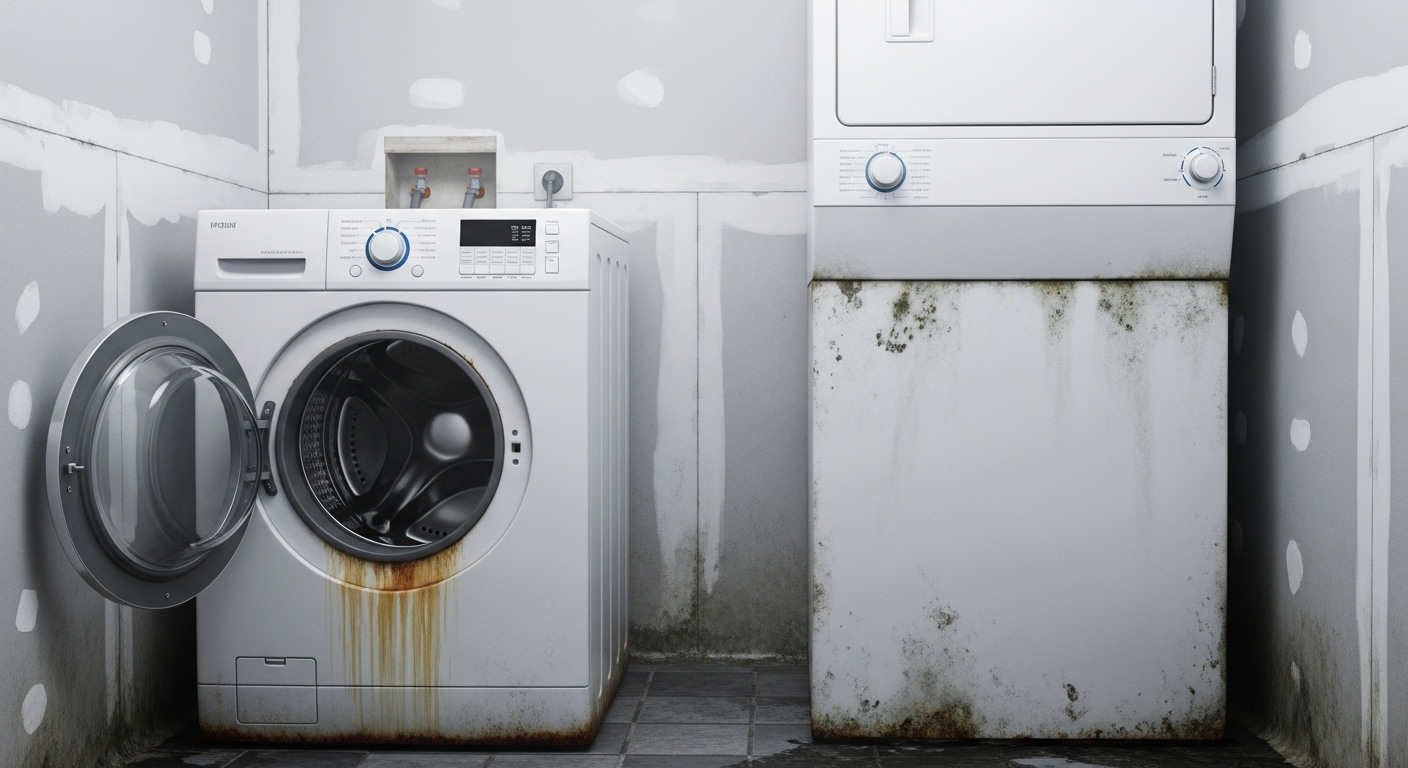Dealing with cannabis grow ops overloading your home’s ventilation and appliances in Vancouver? What you need to know about the hidden infrastructure costs that legal home cultivation creates throughout your house – from humidity damage to HVAC failures and everything in between.
Since cannabis legalization took effect across Canada in October 2018, Vancouver homeowners have discovered an unexpected side effect of their newly legal four-plant home grows: systematic damage to household appliances and ventilation systems that were never designed to handle the massive moisture loads that cannabis plants produce. While the federal Cannabis Act permits adults to grow up to four cannabis plants per household, what most Vancouver homeowners don’t realize is that each mature cannabis plant transpires approximately 400 grams of water per day – equivalent to the moisture output of five to seven typical houseplants. When this enormous humidity burden combines with Vancouver’s already challenging coastal climate, the result is a cascade of failures throughout home infrastructure systems that can cost thousands of dollars in premature appliance replacements and emergency repairs.
The problem manifests across multiple systems simultaneously in ways that homeowners rarely connect to their legal cannabis cultivation. Refrigerators work harder and fail prematurely as compressors struggle against elevated humidity levels. Dishwashers develop electrical malfunctions when moisture infiltrates control boards. Washing machines experience seal failures and corrosion that leads to water damage. Dryers require constant maintenance or early replacement as they battle humidity levels that make clothes-drying inefficient. HVAC systems designed for temperature control – not dehumidification – run continuously at maximum capacity while still failing to maintain comfortable indoor conditions.
Beyond appliance damage, home cannabis cultivation creates serious electrical and fire safety hazards that Vancouver homeowners must understand before setting up grow operations. Even modest four-plant grows require electrical loads of 3,000-5,000 watts during lights-on periods, far exceeding the capacity of standard 15-amp household circuits rated for just 1,800 watts maximum sustained load. When homeowners attempt to bypass electrical limitations through unauthorized modifications – installing oversized circuit breakers or running non-code wiring – they create fire hazards that have historically resulted in electrocutions and house fires throughout British Columbia.

Understanding Cannabis Cultivation Humidity Demands vs. Vancouver Home Infrastructure
The fundamental challenge facing Vancouver cannabis growers stems from a botanical reality that most homeowners underestimate: cannabis plants evolved in warm, humid climates and require robust moisture cycling for optimal growth. Research conducted by the National Collaborating Centre for Environmental Health found that modelling exercises based on typical Canadian housing stock showed that as few as 4-10 mature cannabis plants are sufficient to create moisture issues, which means homeowners operating within legal limits can easily exceed their home’s moisture-handling capacity. This research is particularly relevant to Vancouver because the region’s coastal climate already predisposes homes to moisture challenges that legal cannabis cultivation dramatically exacerbates.

The moisture release from cannabis plants follows specific patterns throughout the growing cycle that compound Vancouver’s existing humidity problems. During the vegetative stage, many growers use humidifiers to maintain relative humidity levels as high as 70% to support young plants until root systems become established. Once plants mature into flowering, they continue their steady 400-gram-per-day transpiration while growers typically maintain higher temperatures to optimize cannabinoid production. Warm air holds more moisture than cool air, so the total moisture burden actually increases during flowering even when supplemental humid
Vancouver’s seasonal humidity patterns create particularly challenging conditions for home cannabis cultivation. Winter growing – which many Vancouver cultivators pursue because indoor methods eliminate seasonal constraints – coincides with the region’s peak outdoor humidity period from October through April. During these months, Vancouver experiences persistently high indoor and outdoor humidity levels that frequently exceed the 30-50% range recommended for optimal appliance operation. When cannabis cultivation adds 400+ grams of daily plant transpiration to homes already struggling with 60-70% winter humidity, standard dehumidifiers become ineffective and HVAC systems cannot achieve setpoints without running continuously at maximum capacity.
Calculating the True Moisture Load of Home Cannabis Grows
Understanding the actual moisture demands of legal home cannabis cultivation requires examining transpiration rates throughout the complete growing cycle. Professional cultivation guidelines specify that cannabis plants transpire approximately 95% of the water they receive, meaning that for optimal growth, a four-plant operation requiring 0.5 gallons of water per plant daily creates approximately 7.6 liters of water vapor that must be removed from the growing environment. However, this calculation assumes perfect irrigation efficiency and fails to account for several complications that dramatically increase actual moisture loads in Vancouver homes.
The timing of moisture release creates concentrated humidity spikes that overwhelm residential systems. Cannabis irrigation typically occurs during 12-hour lights-on periods, so dehumidification equipment must manage concentrated moisture release during specific windows rather than steady, continuous loads. Additionally, few home grows achieve the sealed isolation assumed in theoretical calculations. When grow spaces occupy basements, spare bedrooms, or other integrated home areas rather than professional grow tents, moisture gradually infiltrates adjacent spaces, spreading humidity challenges throughout the residence and forcing primary HVAC systems to struggle with elevated baseline humidity that affects every appliance in the home.
How Home Cannabis Grows Systematically Damage Kitchen Appliances

Kitchen appliances represent some of the most expensive and vulnerable casualties of uncontrolled cannabis cultivation humidity in Vancouver homes. The combination of elevated baseline humidity from plant transpiration and the natural moisture that kitchens generate from cooking and dishwashing creates extreme humidity conditions that accelerate component failures across multiple appliance categories. Refrigerators and freezers, which operate with significant temperature differentials between room temperature and internal cooling compartments, become particularly vulnerable when external humidity levels exceed 60%.
The damage mechanism follows a predictable pattern that Vancouver homeowners can recognize early if they understand what to monitor. High ambient humidity causes refrigerator compressors to run longer and more frequently to maintain target temperatures, reducing equipment lifespan and increasing electricity consumption by 20-30% or more. Extended compressor operation generates additional heat that contributes to overall home humidity, creating a vicious cycle where refrigerators work harder to maintain cooling in humid environments while simultaneously worsening the humidity problem they’re trying to escape. Over time, moisture intrusion into compressor motor windings causes electrical shorts, tripped circuit breakers, or complete motor failure that requires expensive repairs or total appliance replacement.
Dishwashers face particularly severe challenges in cannabis cultivation homes because these appliances generate additional moisture during operation while containing moisture-sensitive electronic components. The high humidity environment from cannabis cultivation combines with steam and moisture that dishwashers naturally produce during wash and rinse cycles, creating internal conditions where electronic control boards experience corrosion and component failure. Vancouver appliance service professionals report increased calls for dishwasher circuit board replacements in areas where home cannabis cultivation has become common, with repair costs typically ranging from $300-400 for parts and labor.
Microwave and Range Hood Moisture Damage
Microwaves and range hoods experience accelerated deterioration in high-humidity environments created by cannabis cultivation, though homeowners rarely connect these appliance failures to their grow operations. Microwaves develop condensation problems when steam from heated food meets cooler surfaces inside the unit, and persistent moisture promotes electrical short circuits and internal component corrosion. Excessive moisture causes rust on internal metal components that can create safety hazards where electrical elements corrode enough to produce arcing or electrical faults.
Range hoods designed to extract kitchen moisture and steam become less effective when home ambient humidity already exceeds 60%, reducing the differential that drives moisture removal. Range hood motors and electronic components experience corrosion from persistent moisture exposure, leading to motor failure, reduced fan speed, or complete malfunction. Additionally, grease buildup on range hood filters becomes more problematic in high-humidity environments because moisture causes grease particles to adhere more tenaciously to filter surfaces, reducing airflow and creating fire hazards that require more frequent cleaning and maintenance.
Laundry Room Equipment Failures from Cannabis Cultivation Humidity

Laundry rooms become extreme vulnerability zones in Vancouver homes with cannabis cultivation because these spaces already function as inherently humid environments where washers and dryers naturally generate significant moisture. When cannabis cultivation adds 400+ grams of daily transpiration to the home’s humidity profile, laundry rooms develop humidity levels regularly exce

